A Country of Regions
Colombia is a biodiverse and multicultural country. Its landscapes, people and culture vary so much depending on cities and departments that you often feel like having reached a different country when visiting another region. However, the Colombian style is still there and is well-rooted in each community, each custom, and each person. Colombia is a country with six natural regions, which are home to more than one hundred indigenous cultures, where 10% of its population is of African descent and which also include Romani people, while maintaining a sense of unity among them.
Traveling through Colombia gives you the chance to enjoy several different experiences in a single country. Each region offers endless possibilities to partake with travelers, natural beauties that range from sunbathing on a paradise beach to climbing a mountain so high that people feel like they are touching the sky; travelers may also enjoy the immense plains that seem endless and feel the intense sun and the aridity of the deserts. Each region is diverse and unique and, if you travel through Colombia, you will discover and experience this variety of climates, adventures, sensations, rhythms, colors, and flavors.
Colombian Natural Regions, a World to Discover
The Caribbean, Pacific, Orinoco, Amazon, Andean and Insular regions are Colombia’s six natural regions, each with its own characteristics and its own customs, gastronomy, and music. The rhythms and dances, for example, vary from region to region and make visiting this country a diverse experience. Colombia and its regions offer tradition, modernity, fun, adventure, disconnection, variety, richness, art, festivities, dances, and music. Each region is defined according to characteristics such as landform, height above sea level, average rainfall, and soil conditions. For example, the Andean region is mountainous while the Orinoco region is flat. The Pacific and Amazon regions have extended periods of rain while the Caribbean is drier. That is why Colombia has no concept of uniformity, and its natural regions are an example of this. In the following pages we will talk about the culture, music, dances, gastronomy, landform, and fauna and flora of these natural regions, which will make you want to travel around Colombia.
Andean Region
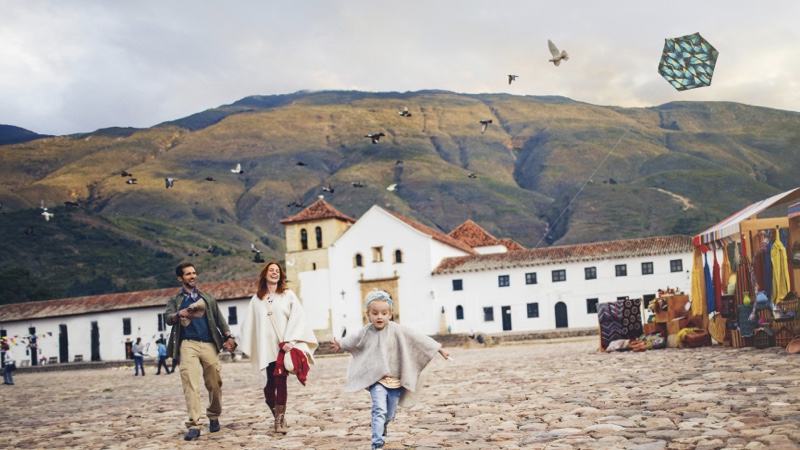
Villa de Leyva, Boyacá.
At the heart of Colombia lies the Andean region, which is crossed by the Andes mountain range, going along the entire western part of South America and which branches out into three parts in our country: the Eastern, Central, and Western mountain ranges. These mountain ranges give life to numerous valleys, canyons, plateaus, moors, snowy peaks and two of the mightiest rivers in the country: Cauca and Magdalena. This region borders to the north with the Caribbean region, to the east with the Orinoco, to the west with the Pacific, to the northeast with Venezuela and to the south with Ecuador. It consists of ten departments and is the most populated area of the country. Among others, this area offers beautiful landscapes of the Coffee Belt, the beautiful and traditional towns in Boyaca, the modernity of Bogota (the country’s capital), and the town often considered as the most beautiful in all of Colombia: Barichara, located in the department of Santander.
-
AREA: 282,450 km² - 24% OF THE NATIONAL TERRITORY
-
POPULATION: 28,863,217
-
CLIMATES: MILD (OCEANIC AND MEDITERRANEAN), TUNDRA AND POLAR
-
PROTECTED AREA: 24 NATIONAL PARKS
DEPARTMENTS:
-
Antioquia (Medellín).
-
Boyacá (Tunja).
-
Caldas (Manizales).
-
Cundinamarca (Bogotá).
-
Huila (Neiva).
-
Norte de Santander (Cúcuta).
-
Quindío (Armenia).
-
Risaralda (Pereira).
-
Santander (Bucaramanga).
-
Tolima (Ibagué).
CULTURAL SUB-REGIONS
The Andean region is characterized not only by its biodiversity, its variety of climates, soils and landscapes, but also for being a culturally diverse area. There are seven cultural sub-regions: The Paisa, Santandereana, Cundiboyasence, Opita, Vallecaucana and Pastusa (these last ones share characteristics with the Pacific region). “Paisas” are known for being wanderers, good traders and troubadours, and for their slurred speech and constant use of words like “pues”, to indicate reason or motive, and “mijo”, an abbreviation of ‘my son.’ The people of Santander are strong and fierce, used to facing dry, yellow, and desert lands. Cundiboyacenses are characterized by their industriousness and attachment to the land, especially the people from Boyaca. The people of Vallecaucanos are cheerful Salsa lovers and party-goers. Opitas are representatives of important music of the region, such as sanjuanero, pasillo and bambuco. People from Pasto are perceived as simple-minded yet noble people using words like “muérgano” (disobedient) and “amartelado” (person overly attached to someone else).
GASTRONOMY IN THE ANDEAN REGION
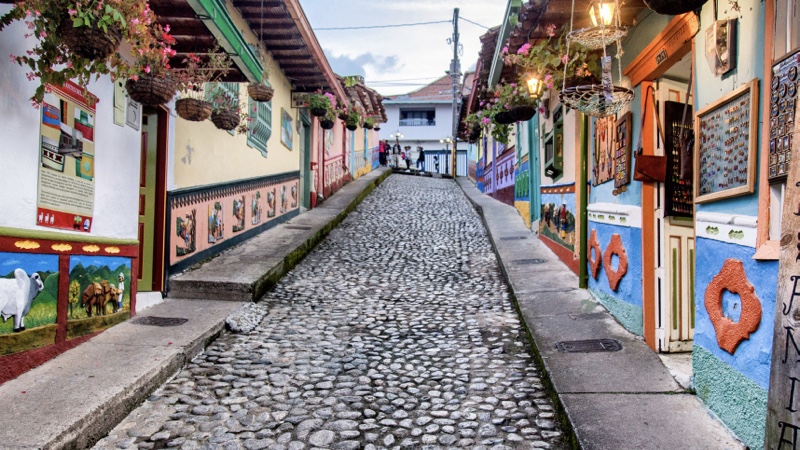
Guatapé, Antioquia.
Colombia is known for its delicious cuisine, colorful dishes and unique ingredients because of the exotic fruits grown here, the creativity of the Colombians, and their ability to keep culinary traditions. Here are some typical dishes from the Colombian Andean region:
-
Tamal: it is prepared with rice, chicken, pork and grains. Tamales are served wrapped in plantain leaves.
-
Rib broth: it is prepared with boiled ribs, sliced potatoes, onions, garlic and coriander leaves.
-
Ajiaco: it is prepared with chicken breast, three different types of potato (Savanna, Pasto and Creole), and guascas (this herb provides the soup with its characteristic flavor). Cream and avocado are added at the table.
-
Bandeja paisa: this is the signature dish of the Andean region. It has beef (ground, stewed or grilled), pork rinds, slices of sweet plantain or patacon, chorizo from Antioquia with lime, arepa, hogao (tomato and onion stew), beans, sliced tomatoes and avocado.
-
Typical Desserts: Bocadillo Veleño (hardened guava jelly), Curuba mousse, milk flan, cuajada with melao (bland cheese and sugar canes concoction), gooseberry and papayuela jam, curuba, almojabana pudin, and flan muisca.
COLOMBIAN ANDEAN MUSIC
Colombian Andean music, also known as the music of the interior, is born of a mixture between the songs of the pre-Columbian Andean peoples such as the Chibchas (with their flutes, ceramic trumpets, maracas and drums), African culture and Spanish European music. Dancing and religious and secular festivities are closely connected to this musical background. Traditionally, the Andean musical groups were called Chirimías (this word has two meanings: group and musical instrument) or Murgas, the latter are more related to the Spanish performances: they were small orchestras with European string instruments: tiples, bandolas, requintos and guitars. Bambuco, torbellino, carranga, guabina, sanjuanero and pasillo are some of the musical styles that stand out from Colombian Andean music.
On the other hand, some of the instruments used for these rhythms include the tiple, the Andean bandola, charango, cane flute, chirimia, quena, zampoña, snare drum, guacharaca, alfandoque, quiribillo, esterilla, chucho, tambora, riolina or dulzaina, guitar, requinto, carraca, marrana, guache, carangano, triangle, bass drum, mate, transverse flute and pan flute.
Amazon Region
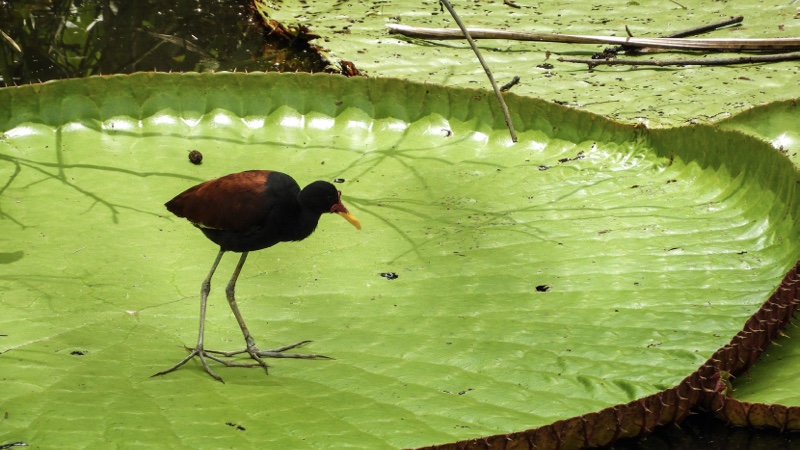
Colombian Amazon.
Southern Colombia is home to the Amazon region, the most forested, remote and least populated area of the country. It is also the region that holds a portion of the most important and beautiful rainforest in the world: the Amazon rainforest, which has thousands of animal and botanical species. But the Amazon region goes much further than that: it includes striking departments, such as Guainia, Vaupes, Caquete, known for their biodiversity and for their cultural heritage and traditions. When traveling to the Amazon region, the opportunity to be amazed by the huge green forest; to meet indigenous communities and participate in some of their rituals; to navigate rivers as large as the Amazon; to fly over Chiribiquete, a national natural reserve that is home to indigenous peoples who have chosen not to have contact with western society; to learn about exotic botanical and animal species and to see the famous jaguar; the largest feline in the Americas, all come to life.
-
AREA: 483,119 km² - 41% OF THE NATIONAL TERRITORY
-
POPULATION: 264,945 INHABITANTS
-
CLIMATES: HUMID TROPICAL AND MONSOON CLIMATE
-
PROTECTED AREA: 10 NATIONAL PARKS
DEPARTMENTS:
-
Amazonas (Leticia).
-
Caquetá (Florencia).
-
Guainía (Inírida).
-
Guaviare (San José del Guaviare).
-
Putumayo (Mocoa).
INDIGENOUS COMMUNITIES:
-
1178 indigenous reserves
-
58,271 registered indigenous citizens
-
Approximately 26,400,000 hectares of reserves
-
94% of its reserves are forests that have not suffered deforestation
AMAZON REGION AND ITS INDIGENOUS PEOPLE
The Amazon Region is the area with the greatest variety in terms of ethnicity, religion, customs, traditions and lifestyles. It is home to 26 indigenous communities with different language families, such as the Tukano, Arawak, Tikuna, Huitoto and Tupi. There are three subregions in which this area of the country can be divided: the region to the north of the Caqueta River, the region between the Caqueta and Putumayo rivers, and the Amazon Trapezium region.
SUBREGION NORTH OF THE CAQUETA RIVER
This part of the Colombian Amazon is located between the Apoporis and Yarí rivers. The indigenous communities that inhabit the area are small groups, usually fewer than 50 people, concentrated in large hamlets or malocas (communal houses). The population that has predominated in this region is that of the eastern Tukano language family: Yucana, Yucana-Matapí, Letuama, Tanimuca, Macuna and Cawiyarí.
SUBREGION BETWEEN CAQUETA AND PUTUMAYO
This region is dominated by the Huitoto indigenous people. They are organized into clans and patrilineal lineages (descendants of a common ancestor through their father) and used to live (some still do) in communal houses such as Malocas. One of their main food products is Casabe, an arepa made from yucca flour.
AMAZON TRAPEZIUM SUBREGION
The Ticunas and Yaguas are the most representative indigenous communities of this region. For the Ticunas, humans are part of nature and their leader is known as Curacas. On the other hand, the Yagua have an independent language, are organized in a multi-family Malocas that house up to 10 families, and are exogamous, i.e. they do not allow marriage between two members of the same Maloca or hamlet.
COLOMBIAN AMAZON GASTRONOMY
To visit the Colombian Amazon is to have the opportunity to taste an exotic and delicious gastronomy, where you can have fish found only in the rivers of this region, like the pirarucu; where the natives make unique and original preparations, like the moqueado fish, and even where worms, like the mojojoy, are prepared to delight and offer new experiences to travelers.
-
Pirarucú: the largest freshwater fish in the world (it can measure up to three meters). It is served fried.
-
Fish Patarasca: hunks of fish wrapped in Calathea Lutea leaves a plant known in Colombia as “Congo leaves”.
-
Moqueado fish: fish smoked in plantain or guaco leaves for hours or even days.
-
Casabe: tandioca or yucca-based crunchy dough.
-
Ajicero: typical fish broth from the department of Guainia made with pepper seeds to make it spicy.
-
Copoazú Cream: copoazú (a highly nutritious fruit) pulp mixed with condensed milk.
-
Boruga: small rodent mammal that is fried or grilled.
-
Mojojoy: fat white worm that can be eaten whole and alive, fried or grilled.
-
Smoked Cachama: typical fish from the department of Caqueta.
-
Fariña: ground flour made from the yucca plant. Also known as “yuca brava”.
MUSIC OF THE COLOMBIAN AMAZON
Music in this region of the country can be considered a hybrid, since it is influenced by both indigenous people and those of the bordering countries, especially Brazil and Peru, and by the rhythms of other Colombian regions, such as the Andean and Caribbean regions. However, despite this blend, Amazonian music is characterized by its originality and the use of traditional instruments made from natural elements. There are 3 categories in which the music of this region can be divided: indigenous, national and frontier music.
INDIGENOUS MUSIC
The music of the indigenous peoples is characterized by songs, tunes and sounds that imitate the animals and elements found in the jungle, with simple and repetitive melodic patterns. These songs have a deep cosmic evocation given their spiritual background. The flute, which they make themselves, is the most important instrument, but other wind instruments are also used, such as the wood trumpet, capadores, and jurupari (yuruparí or yuruparý) ceremonial trumpet. The shell trumpet, also known as seashell horn or conch, is widely used. There are also percussion instruments such as the manguare, drums, bells and ceramic or wooden rattles.
NATIONAL MUSIC
The music of the other Colombian regions arrives in the Amazon to blend with native rhythms and thus create new proposals for Andean and rural expression. It is common to hear Amazonic versions of Andean music such as pasajes, joropos, bambucos and pasillos and Caribbean music such as cumbias, merengues, calypsos and porros.
FRONTIER MUSIC
The influence of bordering countries in the music of the Colombian Amazon is undeniable. Genres such as mixtianas, waltzes, marineras and huaynos come to this area from Peru and marchas, sambas, forros, xotes, dobrados and buteques from Brazil.
Pacific Region
The Colombian Pacific is one of the most beautiful and rhythmical regions in Colombia: it is the setting for the biodiversity of the Choco rainforest, offering breathtaking seascapes like Nuqui, cultural cities like Cali, lush vegetation such as Nariño’s, and is also home to the indigenous peoples of Cauca.
This region is bathed by the Pacific Ocean, and is the area with the largest Afro-Colombian population in the country, as well as the ancestral territory of the indigenous communities Embera, Wounann, Gunas (Kunas) and Awa. The Pacific region is divided into two: North Central Pacific, which extends from the mouths of the San Juan River to the border with Panama, and the South Central Zone, which covers the departments of Valle del Cauca, Cauca and Nariño.
-
AREA: 83,170 km² - 7% OF THE NATIONAL TERRITORY
-
POPULATION: 1,500,753 NHABITANTS
-
CLIMATES: HUMID TROPICAL AND MONSOON CLIMATE
-
PROTECTED AREA: 7 NATIONAL PARKS
Departments:
-
Valle del Cauca (Cali).
-
Chocó (Quibdó).
-
Cauca (Popayán).
-
Nariño (Pasto).
NATURAL SUB-REGIONS
-
Baudo Serrania
-
Darien Serrania
-
Atrato River Valley
-
San Juan River Valley
-
Pacific Coast Plains
THE PACIFIC, AFRO-COLOMBIAN CULTURE AND CULTURAL EXPRESSIONS
In the Pacific, color, flavor and sound mix perfectly to provide travelers with an experience that brings them closer to the African culture. The cities where Afro-Colombianism predominates are Tumaco, Buenaventura and Quibdo. Music and gastronomy are the most outstanding aspects of this area of the country.
GASTRONOMY IN THE COLOMBIAN PACIFIC
The flavor and creativity of Colombia’s Pacific cuisine are known throughout the country. Most of its typical dishes are based on seafood, since it is a coastal region, and are accompanied by vegetables. The most popular fish in this area are bocachico (Prochilodus magdalenae) and cod; pickled or fried, boiled, stewed and in soups. There are also dishes with prawns and seafood.
-
Bocachico in coconut juice: bocachico (fish) cooked in coconut milk, water, lemon juice, beans, onion, Creole peppers, ripe tomatoes, butter, cumin, salt and pepper.
-
Atollado rice: rice, chicken, onion, tomato, shredded pork, pork ribs, sweet peppers, red peppers, potatoes, ground pepper, cumin.
-
Catfish casserole: catfish cooked over a low heat with local seasonings and dressing. At the end of the preparation, cream is added.
-
Chautiza: freshwater shrimp that is fried in seasoning and coconut milk. It is known as the caviar of the Pacific.
-
Prawn head cream: ground prawn heads in coconut milk and local seasonings.
-
Coal-grilled cuy: cuy (guinea pig) with annatto oil, black pepper, ground garlic, cumin, pepper, oregano, potatoes, salt and pepper.
-
Fish with Chocoan lulo: fish stuffed with sliced Chocoan lulo.
-
Crab Soup: mixture of crab, and regional vegetables and seasonings.
-
Fresh Avocado Juice: juice made with avocado and milk.
-
Chancacas: shredded coconut cooked with panela and flavored with orange or lime leaves.
MUSIC FROM THE PACIFIC REGION
The music of the Pacific is a source of pride for Colombia. Different rhythms and dances converge and have a shared quality of flow and joy. In this area, there are rhythms as diverse as chirimia, which dates from the traditional Spanish military bands that arrived in the area at the time of the conquest, others like currulao, juga, the boa songs, gualí, chigualo, tamborito, mazurca, contradanza, jota, abozao, aguabajo, pasillo, bambazú, porro chocoano, patacoré, old bambuco, pango, caderona, berejú, velorio de santo and novenario. Additionally, Cali is known as the world capital of salsa for its strong appropriation and contribution to this musical genre, and it is the birthplace of some of its most important artists. For the Afro-Colombian population in the South Pacific, marimba music and traditional songs and dances are expressions that are part of the family fabric and community, as they sing in the form of stories and poems at religious, festive and ritual events. The declaration of this genre as Intangible Cultural Heritage by UNESCO is proof of its importance. There is a current demand for music from the Pacific and a varied range of artists who are reinventing the rhythms of the region, which are widely recognized both nationally and internationally.
Caribbean Region
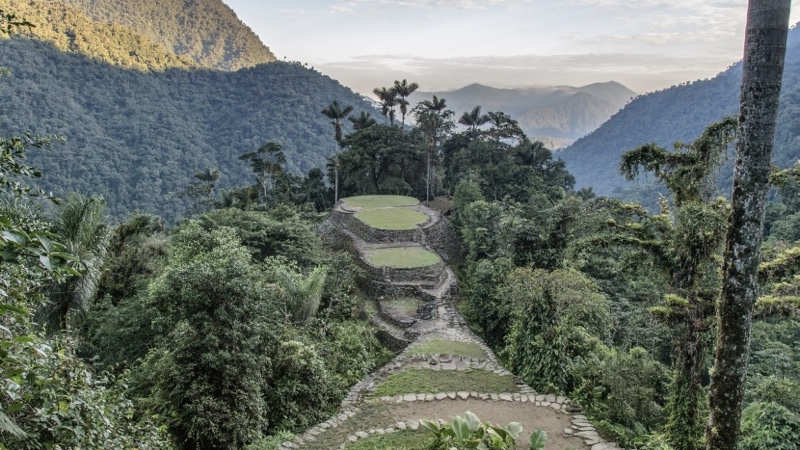
Lost City, Santa Marta.
In the north of Colombia, bathed by the Atlantic Ocean, is the Caribbean region, which, despite being divided into seven departments, has a very uniform cultural identity influenced by the Caribbean Sea. The locals of this region are known as “costeños” (coast folk) and have a significant Afro influence. In the past, the way in which the cities of the Colombian Caribbean connected with the departments of the interior was through boats that sailed rivers such as the Magdalena. This region has tourist destinations as striking and unique as the Sierra Nevada de Santa Marta, the Rosario and San Bernardo coral reefs, and the Tayrona Park.
-
AREA: 132,288 km² - 11,6% OF THE NATIONAL TERRITORY
-
POPULATION: 10,301,982 INHABITANTS
-
CLIMATE: DRY TROPICAL AND DRY CLIMATE (IN la GUAJIRA AND CESAR), WITH MILD OCEANIC CLIMATE IN the SIERRA NEVADA DE SANTA MARTA
-
PROTECTED AREA: 11 NATIONAL PARKS
DEPARTMENTS:
-
Atlántico (Barranquilla).
-
Bolívar (Cartagena).
-
Cesar (Valledupar).
-
Córdoba (Montería).
-
La Guajira (Riohacha).
-
Magdalena (Santa Marta).
-
Sucre (Sincelejo).
-
San Andrés y Providencia (San Andrés).
WILDLIFE SANCTUARIES
-
Los Flamencos (La Guajira)
-
Cienaga Grande de Santa Marta (Magdalena)
-
Los Colorados (Magdalena)
-
San Jacinto (Bolivar)
-
El Corchal “El Mono Hernandez” (Sucre – Bolivar)
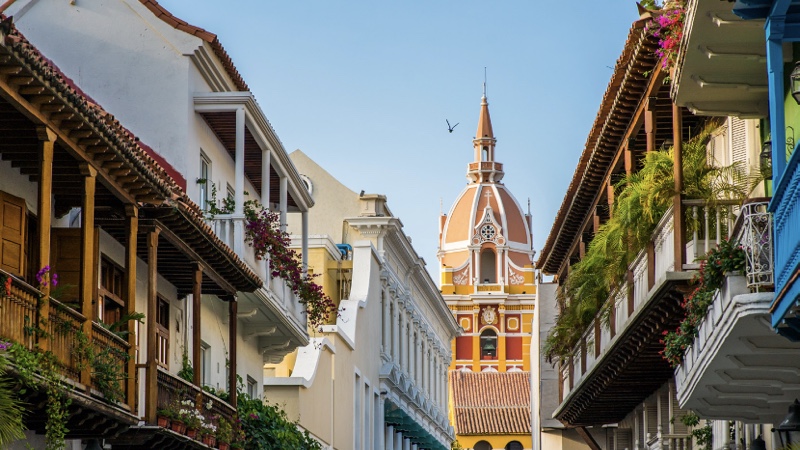
Cartagena de Indias.
SUBREGIONS IN THE COLOMBIAN CARIBBEAN
Guajira Peninsula This is a semidesert area, mountainous to the south and flat to the north. The indigenous Wayú community populate the Guajira desert.
Sierra Nevada de Santa Marta This mountain range is a clear example of the different thermic floors in Colombia. It is a mountain massif separated from the Andes by a system of valleys formed by the rivers Cesar and Rancheria. This mountain is nearly 6,000 meters high, the highest in Colombia and where the climate reaches 30 °C at its lowest point and 0 °C at its highest point. Its snowy peak, at 5,775 meters above sea level, is called the Cristobal Colon peak.
Great Savannas and Plains of Magdalena This subregion includes the Banana Zone, the Cesar Valley, the Lower Magdalena and the Bolivar Savannas. These are low-lying areas with a wavy landform and small mountainous formations.
Mompox Depression This area is characterized by numerous marshes and many swamps.
GASTRONOMY IN THE COLOMBIAN CARIBBEAN
The gastronomy of this region is a mixture of ingredients and flavors from different cultures: European, indigenous, African and mestizo. Here, the sancocho, the grains and dishes prepared with wild game are some of the most popular.
-
Sancocho: broth that can be based on different types of meat; fish and seafood, chicken, beef, pork, turtle, goat, ribs and tripe.
-
Cayeye: green banana, cooked with its peel and crushed into a mash. It is usually mixed with butter or sour cream.
-
Liza Rice: rice based on liza (sea fish) served on a bijao leaf and alongside patacones, yucca, avocado, coast sour cream, boiled egg or corn roll.
-
Arepa’e huevo: fried corn arepa with an egg inside.
-
Cheese mote: soup made of yam and pieces of costeño salty cheese.
-
Coconut rice: dish prepared with coconut milk and sweetened with panela and sugar.
-
Butifarra soledeña: pork sausage that is usually accompanied by lime and yucca rolls.
-
Bollos: wrapped in corn husks. There are yucca, plantain, corn, clean bollo (made with white corn) and angel (with white corn and anise).
-
Carimañola: long and fried yucca dough stuffed with cheese or ground beef.
-
Sweets: coconut, milk, papaya, tamarind, hicaco, yam, yucca, rice and beans.
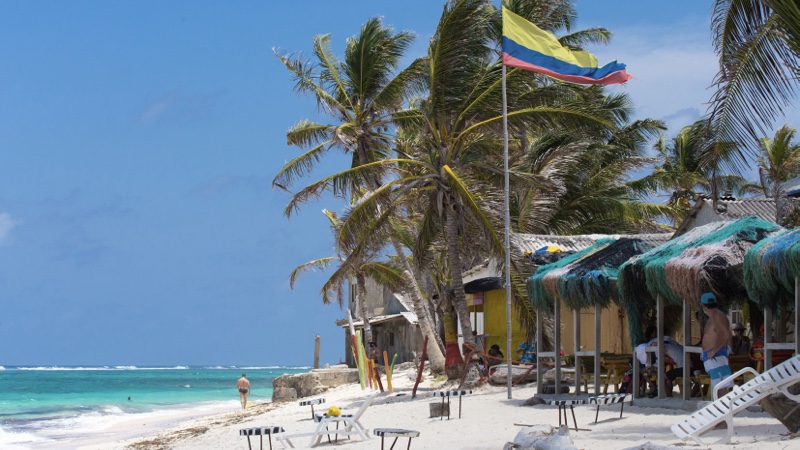
San Andres island.
MUSIC OF THE COLOMBIAN CARIBBEAN
The Caribbean region is an area where music and dance are essential elements of local culture, and where some rhythms are native and others have a European influence. Vallenato, cumbia, porro, son sabanero, fandango, mapale, son de negro, and zafra, are some of the relevant musical genres in this region
-
Vallenato: a genre that emerged from the mixture of cowboys, Africans, indigenous rhythms and dances of Sierra Nevada. It is one of the most important musical styles in the Colombian Caribbean region. The importance of vallenato motivated UNESCO to declare it an Intangible Cultural Heritage.
-
Cumbia: is one of the cultural symbols of Colombia. Its roots lie in the rhythms of indigenous, African and European cultures. The drums, maracas, guache and whistles of indigenous origin are the preferred instruments for this rhythm.
-
Gaita: a genre inherited from the colonial times that is characterized by the use of gaitas (cactus bark flutes).
-
Mapale: Afro-Colombian dance rhythm that celebrated the catch of a mapale fish.
-
Porro: considered the son of cumbia. It is characterized by a strong Afro influence; however, it also has elements of indigenous peoples and European music.
Orinoco Region
The Orinoco is also known as the Eastern Plains. It is a long, winding plain consisting of 75% savannas and 25% forest areas. This region is delimited by the Orinoco, Guaviare, and Arauca rivers and the Piedemonte llanero, the area where the mountain ranges border the eastern plains. The savanna deer, capybara and cotudo monkey are some of the mammal species found in this extensive area. Also, Over 450 bird species inhabit this region, many of them, such as the Orinoco goose, are aquatic birds. This area of the country is home to one of the most beautiful places in Colombia: Caño Cristales, the river of five colors, which produces a visual effect very similar to a liquid rainbow thanks its multicolored aquatic vegetation.
-
AREA: 285,437 km² - 18% OF THE NATIONAL TERRITORY
-
POPULATION: 1,681,273 INHABITANTS
-
CLIMATE: DRY TROPICAL AND MONSOON
-
PROTECTED AREAS: 4 NATIONAL PARKS
DEPARTMENTS:
-
Arauca (Arauca).
-
Casanare (Yopal).
-
Meta (Villavicencio).
-
Vichada (Puerto Carreño).
NATURAL SUB-REGIONS
-
Piedemonte Llanero
-
Meta Mesetas
-
Guaviare Plains
-
Arauca Swamps
LLANERO CULTURE
The main economic activity of the Orinoco region is extensive cattle raising, which culturally influences not only the way llaneros work, but also their housing, clothing, gastronomy, rhythms, and music. The most recognized cultural expression of this area is coleo (a sport where a man on horseback knocks down a bull by pulling its tail) and llanero music.
TYPICAL DISHES FROM THE EASTERN PLAINS
Beef is the star the Orinoquia’s gastronomy: dishes such as veal or mamona a la llanera aare well-known throughout the country for their excellent and unquestionable flavor of llanero origin. However, this cuisine, as in other regions, is also diverse. Not only is beef served here, but also chicken broth, grilled capybara, rabbit in wine and many other animals.
-
Veal or mamona a la llanera: beef in four cuts known as raya, garza, tembladores and osa. This meat is strung on 2-meter sticks vertically and roasted on a small wood fire.
-
Gumarra boil: chicken soup with potatoes, yucca, squash, green plantain and seasoned with cilantro leaves.
-
Roasted cachama a la llanera: cachama (fish) threaded on orange tree sticks and roasted over a wood fire.
-
Grilled capybara: Capybara meat marinated in salt and sometimes beer and onions, then placed on a coal grill.
-
Llanero rice: rice marinated with beef tail and sauteed with lard.
-
Plantain tungo: sweet plantain dough, corn flour and lard.
-
Hallaca: corn dough filled with beef, pork or chicken, vegetables, olives, raisins, nuts and capers, seasoned with chicken broth, pigmented with annatto and wrapped in plantain leaves.
-
Palo a pique: beans cooked with meat, to which pork rinds, chicken broth, spices, seasonings and rice is added later.
-
Cachapa: thick yellow corn tortilla prepared with eggs, sugar, milk, oil and salt.
-
Conejo en vino: diced rabbit meat with herbs, spices, flour, broth and white wine.
MUSIC FROM THE ORINOCO REGION
The Eastern Plains region makes foreigners and locals vibrate and stomp the ground to the sound of the harp, cuatro and maracas. Their music is a mix of Spanish and indigenous influences that results in an inspiring expression of Colombian cowboys’ interaction with daily life and nature. Dance and rhythms are closely linked in the music of this region. Joropo, galeron and pasaje are the main musical expressions. Other genres found here include: seis, zumba que zumba, quirpa, carnaval, San Rafael, periquera, chipola, pajarillo, gavan, guacharaca and perro de agua. These musical genres are accompanied by instruments such as cuatro llanero, the bandola llanera, maracas, carrizo, furruco, mandolin, guitarro, the electric bass and the sirrampla.
-
Joropo: this rhythm is impossible to dissociate from its dance, consisting of pairs and characterized by strong stomping footwork by men. The musical instruments showcased in this genere are the harp, the cuatro and the maracas.
-
Galeron: also known as corrido or torbellino llanero. This dance also includes footwork by men but, unlike joropo, there is a movement here where women escape from the men and are chased by them.
-
Pasaje: like in joropo and galeron, there is footwork, but slower and not as bold.
Insular Region
Scattered across the two oceans that bathe Colombian shores lie the islands that make up the insular region and are connected to the mainland through underwater platforms. This region’s includes both the islands of the Caribbean Sea and those of the Pacific Ocean. Its climate is beautifully tropical and its islands are outstanding tourist spots, such as the San Andres island, known for its coral reefs and its seven-colored sea. Species such as lobsters, hawksbill turtles, green turtles, manta rays and jellyfish are common in this region. Between April and May, the nesting of black land crabs can be witnessed.
-
AREA: 300 km²
-
POPULATION: 74,620 INHABITANTS
-
CLIMATES: DRY TROPICAL AND HUMID TROPICAL
-
PROTECTED AREAS: 4 NATIONAL PARKS
DEPARTMENTS:
-
San Andres y Providence
-
Bolivar (San Bernardo Islands - Rosario Islands)
-
Cauca (Gorgona Island)
-
Valle del Cauca (Malpelo Island)
NATURAL SUB-REGIONS
-
Old Providence McBean Lagoon Natural Park
-
Rosario and San Bernardo Islands Coral National Natural Park
-
Gorgona National Nature Park
-
Malpelo National Natural Park
SUBREGIONS OF THE INSULAR REGION
Archipelago of San Andres and Providencia One of the most desirable tourist destinations in Colombia. It is bathed by the Caribbean Sea and has a total area of 52.2 km ², (San Andres with 26 km ², Providence with 17 km ² and Santa Catalina with 1 km ²).
Gorgona Island It is a small system of islands formed by Gorgona, Gorgonilla and other islets, all located in the Pacific Ocean with 26 km² of land or island surface.
Malpelo And island of volcanic origin in the Pacific Ocean.
San Bernardo Archipelago It consists of 10 islands in the Caribbean Sea located in the Morrosquillo Gulf.
OTHER GROUPS OF ISLANDS:
-
Rosario Coral Islands
-
Fuerte Island Tortuguilla Island
-
Tierra Bomba Island
TYPICAL DISHES FROM THE INSULAR REGION
The flavors of the sea are the gastronomic essence of the Insular region. Dishes here are prepared with marine species such as fish, crab, lobster and snails, and are usually accompanied by fruits and vegetables typical of the tropics, such as yucca, plantain, squash, and coconut. Basil, cinnamon, cloves and ginger are widely used spices that provide a unique flavor to the gastronomy of this region.
-
Rondon or Run down: stew or soup cooked with coconut milk and to which fish, snails, yam, yucca, green plantain, pork tail and flour tortillas are added.
-
Crab soup: black and red crabs cooked with pork tail, potato, yam, flour tortillas and spices.
-
Crab or fish balls: deep-fried balls of fish, crab or lobster meat seasoned with eggs, breadcrumbs, various vegetables and spices.
-
Cocadas or coconut sweets: cookie-like sweets prepared with coconut pulp, coconut milk, sugar, butter and flour.
-
Snail ball: stewed and fried in coconut oil.
-
Chicken stew with dumplings: chicken seared with coconut oil and cooked with garlic, pepper, onion, salt, celery and dumplings. The latter are chunks of wheat flour dough, coconut milk, salt and fat, steamed or boiled.
-
Journey cake: baked rolls where wheat flour has been kneaded with coconut milk, salt and sugar.
-
Crab empanadas: wheat flour dough filled with crab meat seasoned with onion, garlic and paprika.
-
Beans and pig tail: beans with pig’s tail and fried onion, garlic, and paprika seasoned with sugar and salt.
-
Bammy: grated and fully squeezed yucca that is fried until golden-brown. It is a side dish to many dishes of the region.
MUSIC OF THE INSULAR REGION
The Insular region, although one of the smallest in Colombia, is very culturally diverse, as it is bathed by two oceans and encompasses both Caribbean and Pacific culture. In addition, the international influence is present in this region especially in dances and music, as is the case of Calypso, typical of Trinidad and Tobago, and Jamaican rhythms, such as reggae. Salsa, merengue, vallenato and mazurka are also popular genres in this region. To play these rhythms, the islanders use instruments such as the carraca or mandíbula (horse jawbone), the mandolin, the tinafono or tijano, the guitar, the violin and the accordion.























